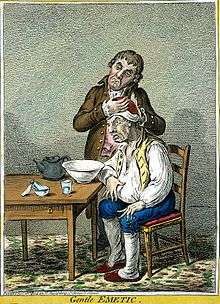Heroic medicine

Heroic medicine was the tradition in European medicine that encouraged the use of treatments with immediate effect, even at substantial risk to the patient. The treatments most commonly used were bloodletting and purging of the digestive tract. Heroic methods dominated medical practice in the 18th and early 19th centuries, but were displaced from the mid-19th century onward by the rival "conservative" approach.[1]
During the "Age of Heroic Medicine" (1780–1850),[2] educated professional physicians made extensive use of bloodletting (venesection[2]), intestinal purging (calomel), vomiting (tartar emetic), profuse sweating (diaphoretics) and blistering, stressing already weakened bodies.[3] Physicians originally treated diseases like syphilis with salves made from mercury.[4] While well-intentioned, and often well-accepted by the medical community, these treatments were actually harmful to the patient.
See also
References
- ↑ Flint, August (1874) Essays on Conservative Medicine
- 1 2 Weil, Andrew (2004). Health and healing: the philosophy of integrative medicine. Houghton Mifflin Harcourt. p. 12. ISBN 978-0-618-47908-5.
- ↑ Singh, Simon; Ernst, Edzard (2008). Trick Or Treatment: The Undeniable Facts about Alternative Medicine. W. W. Norton & Company. p. 108. ISBN 978-0-393-06661-6.
- ↑ Dary, David (2008). Frontier medicine: from the Atlantic to the Pacific, 1492-1941. Random House, Inc. p. 30. ISBN 978-0-307-26345-2.